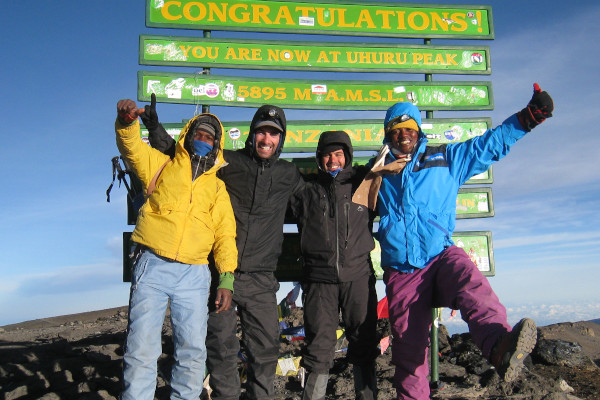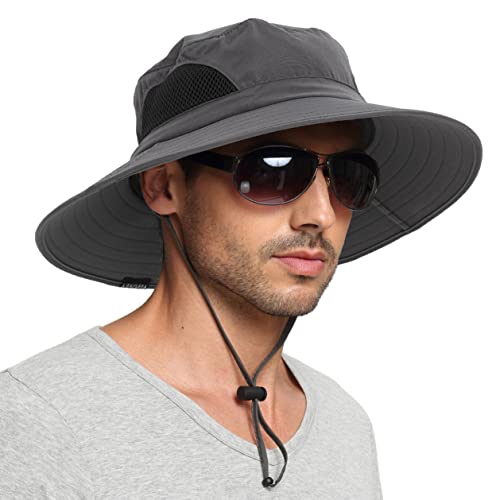There are five mandatory Kilimanjaro headgear accessories that you need to take on your Kilimanjaro climb.
Below I've provided detailed descriptions on each as well as set out some specific brand recommendations.
Once you've read this article see my complete Kilimanjaro equipment list, and my guide to trekking Kilimanjaro.
My Quick Takeaways:
Preparing for your Kilimanjaro climb? Don't forget these essential headgear items:
- Sun Hat with Neck Cover: Protects against intense sun exposure at lower elevations.
- Thermal Beanie or Headband: Keeps your head and ears warm during cold summit nights.
- Neck Warmer or Balaclava: Shields your neck and face from cold winds and sunburn.
- Headlamp with Spare Batteries: Essential for pre-dawn summit attempts and navigating campsites in the dark.
- High-Quality Sunglasses: Protects your eyes from strong UV rays and glare from snow at higher altitudes.
Equipping yourself with the right headgear ensures comfort and protection against Kilimanjaro's diverse weather conditions. For a detailed breakdown, check out my complete guide on Kilimanjaro headgear.

Plan your Kilimanjaro trek
Get a quote from my recommended local Kilimanjaro operator
Kilimanjaro Headgear- 5 Essential Items
1. Sun Hat (ideally with neck cover)
You are going to want to have a good hat with you for the climb to protect your face from sun burn and keep your head cool.
I like hats that have an adjustable neck cover. Make sure the hat is made from a material that breaths well.
The hat should fit comfortably in your daypack as you don’t want to have to hold the hat every time you want to take it off.
2. Beanie or Headband
3. Neck Warmer
To protect your neck and face from blistering cold temperatures if the wind picks up, high Sun UV during the mid-afternoons at altitude, or indeed to cover your mouth and nose from dust, I recommend taking either a hiking balaclava or neck warmer.
Make sure to get something that is lightweight, absorbent, breathable and quick-drying.
Great options here.

Plan your Kilimanjaro trek
Get a quote from my recommended local Kilimanjaro operator
4. Headlamp
A headlamp is the best torch for night hiking as you can have your hands free at all times. You will use your headlamp on summit night (yes, you summit over night, starting usually around midnight).
The key things to look for in a good hiking headlamp are:
- Light / brightness quality: The higher the brightness the better. Of course this comes at a costs to battery life. Ideally you want a max beam distance of greater than 70 meters and a light output of greater than 100 lumens
- Battery life: The longer the better. This often means the headlamp needs to hold more batteries, which in turn makes it heavier. I recommend a minimum high mode run time of 30 hours. If your headlamp uses batteries, be sure to pack spares.
- Weight: As you are carrying this device on your head, the lighter the better. No more than 230 grams
Here are my recommendations:
Best Headlamp: Black Diamond Storm
The Black Diamond Storm is a brilliant headlamp. It puts out 350 lumens of light, is lightweight, can easily be transitioned from full power to dimmed light, and is also waterproof up to 1m immersion for 30 minutes.
Alternatively the Black Diamond Spot is a great lightweight headlamp (weight = 93 grams, 90 Lumens, 50 hours high mode battery life, 70 meter max beam distance).
Best Value Headlamp: Petzl Tikka
Petzl make great headlamps and many of their brands would be worth mentioning here, but the one that I think deserves specific mention is the Petzl Tikkina.
The Tikkina is super light at 86 grams, provides decent battery life (up to 80 hours on high mode) and rather good light output for it’s size (max beam distance of 80 meters and 150 lumens of light output.

Plan your Kilimanjaro trek
Get a quote from my recommended local Kilimanjaro operator
5. Sunglasses
When it comes to sunglasses and Mount Kilimanjaro, there are two considerations you need to take into account.
First is the UV intensity, which at just under 6,000m is very high. This can be very damaging to your eyes if you don’t have good sunglasses.
The second factor is the snow cover, which acts to reflect and intensify visible light.
Again too much visible light is damaging to your eyes (imagine staring into the sun to get a sense of high altitude trekking without sunglasses).
The undisputed leader in high altitude sunglasses are Julbo.
All Julbo lenses offer 100% protection from UVA, B and C rays, and there category three and four rating lenses block up to 90% of visible light, making them perfect for Kilimanjaro. Category three and below are fine for driving or wearing around the town.
Julbo’s most versatile lens is the Camel which gets darker and lighter depending on the light intensity – i.e. it ranges from Category 2 to 4. It’s a transition lens that comes in many different models, I recommend two models for Kilimanjaro trekking excursions:
Julbo Montebianco (Mens) or Monterosa (Womens)
The Julbo Montebianco for men and the Julbo Monterosa for women are the most versatile in their range and have designs that would work equally well in a non-mountain environment.

Plan your Kilimanjaro trek
Get a quote from my recommended local Kilimanjaro operator
My Final Thoughts
And there you have it: A quick list of the essential Kilimanjaro headwear accessories you must takle with you. Did I miss anything? Let me know in the comments below and let's share the love!
Check out my other lists of equipment for Kilimanjaro:







Just wanted to update on the head Lamp. The Black Diamond Storm is cheaper, lighter , and more powerful. No compliants yet.
Yip, the Storm is a great product. For other headlamp recommendations, check out: https://www.mountainiq.com/gear/best-headlamps-for-hiking/
Hi, climbing Kilimanjaro in July. Struggling to find sunglasses as I wear spectacles and need glasses to cover them, or go for a goggles. Have been looking at ski goggles but I need to make sure that they are going to give me the protection that I need. A friend of mine climbed last year and had very painful sore eyes on day 2 Can you help?
Hi Jan, ski goggles are a little overkill for Kilimanjaro. As you get near the summit it is possible to encounter quite a bit of snow, and ski goggles can help, but generally I would go for a prescription pair of polarised sunglasses. Or perhaps check if your optometrist can recommend a lens cover for your spectacles. Alternatively, you can use contact lenses for the trek with mountain sunglasses – that’s what I do.
I also wear prescription glasses and would prefer sunglasses with prescription rather than wearing contacts and these over them. Contacts would be a hassle to take care of. What should I look for in prescription sunglasses? Just a high VU protection? How high? What other features? Thanks!
Hi MJ, a good pair of polarized prescription sunglasses will do the job. In terms of priority, I would say sight comes first and then UV protection. As long as they are polarized you will get relatively good protection from UV. All the best!
The Julbo MonteRosa have three options
– Spectron 4
– Camel
– Zebra
Is one better than the other? Is there another option other than Julbo that would work, or is Julbo basically the best there is so that’s the one to stick with?
Hi Mark,
For the Julbo explorer sunglasses which type of lens would you recommend for Mt Kilimanjaro?
There is a difference of opinion in the information I have read about whether polarised lenses are a plus or minus. What is your experience?
Cheers
Jim
Hi Jim, Polarised lenses are a bit overkill on Kilimanjaro. Anything is Julbo’s non-polarised range will do the job great and still be functional off the mountain. All the best!
Hello,
Thank you for this comprehensive kit list.
We would be undertaking the climb during autumn.
On another webpage it was recommended that the sunglasses should be more like ski glasses, with side protection, to provide better protection and because of the dust. What are your views on this?
Many thanks,
Pete
Hi Pete, Generally ski glasses or goggles are not required on Kili, but if you have a pair it wouldn’t be a bad idea to keep them in your pack just in case of heavy snow fall on the summit. I recommend high UV protection sunglasses. If you can get a pair with a wrap around effect that is even better. Scree dust on the upper reaches of Kilimanjaro can be a big nuisance, particularly on the descent. I recommend Julbo Explorers
Hello,
Going along with the question posted above, are there sunglasses that can fit over a pair of prescription glasses?
You can definitely get standard prescription sunglasses that have a high UV protection. These will be fine for Kilimanjaro. You don’t need to get Julbos and I’m not even sure they are available with a prescription. But a I said, standard sunglasses with a prescription are readily available and would be fine for your climb. All the best!
Hi,
I bought your book and it is an excellent guide.
Regarding eye-wear, I wear prescription eye wear normally and not contact lenses. Can you suggest some options here – mountain + prescription glasses?
Thanks.
Kash
Hi Kash, delighted you found the book useful. Without spending too much money, I do not think it is possible to get sensibly priced prescription sunglasses that are designed for high altitude mountains. I recommend you either purchase good clip on UV lenses that you can attach to your prescription spectacles or if you are able to use contact lenses, use them along with a good pair of sunglasses. Along with protecting your eyes from the intense sun, sunglasses help shield the eyes from dust – the upper slopes of Kibo consist of very fine galcial silt that can easily lodge itself in one’s eye and cause conjunctivitis. It’s happened to me once. Hope this helps.
Mark